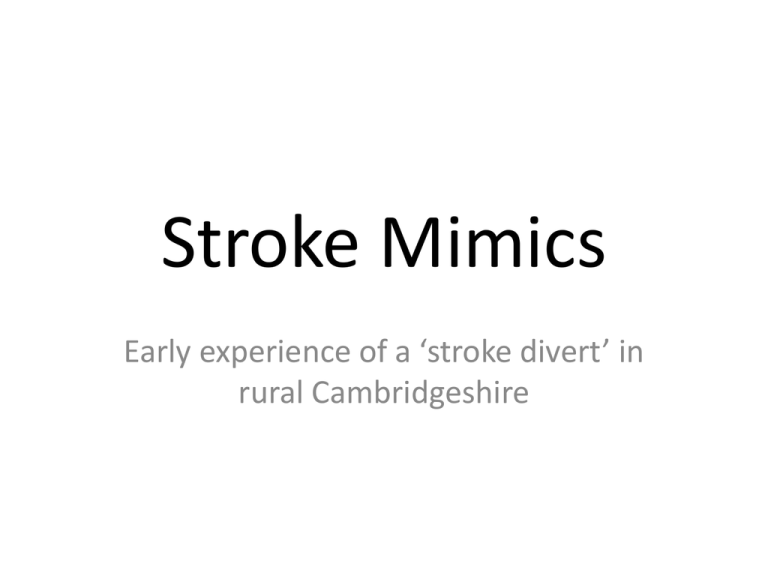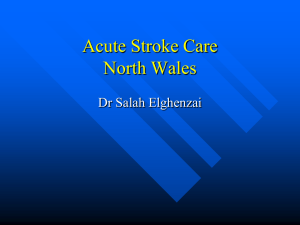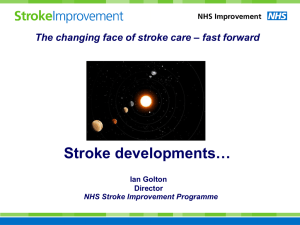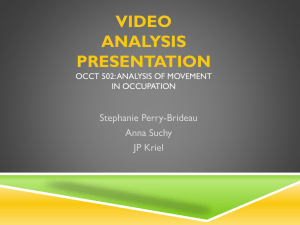
Stroke Mimics
Early experience of a ‘stroke divert’ in
rural Cambridgeshire
What’s a Stroke mimic?
A patient labelled as suffering either stroke/TIA
or possible stroke/TIA, subsequently
diagnosed with another condition
Mimic activity
• What mimic rate did we expect?
• 30% often quoted
• 2011, 50% coming from UCL HASU
• Can London really monitor this activity?
(UC)London HASU data
ABN 2012: CHANGES IN WORKLOAD AND CASE MIX IN A LONDON HASU
OVER TIME J Winston, et al. Royal Free; UCL
Audit admission rates and case mix over 15 months.
Admission rates increased linearly.
Thrombolysis call rates did not contribute significantly to this increase.
Case mix changes assessed by studying discharge summaries from 2 months
1 year apart (October 2010 and 2011).
Male bias in 2010 and a female bias in 2011 (p<0.05 by χ2test).
Number with a TIA/infarct/ICH was similar (127 and 128).
Number of non-stroke diagnoses at discharge increased significantly (46 to
76).
Implications for acute general neurological/stroke services in the UK.
Mimic literature review
Fernandes PM,Whiteley WN,
Hart SR, et al.
Pract Neurol 2013;13:21–28.
Figure 1 The proportion of suspected stroke patients with an eventual diagnosis of stroke or TIA, from a systematic review and metaanalysis of case series, stratified by the context of assessment (emergency department, primary care, stroke unit/neurovascular clinic,
ambulance or other referral sources). The width of each diamond represents the 95% CI of the pooled proportion
New pathway
• 60% of Hinchingbrooke catchment diverted to
CUH
– Balance to PDH
The flow diverter
• Ambulance tool
• Hinchingbrooke ED attendees assess with
Rosier
• In Hosp cases discussed
– NB; Manchester divert for Tpa only with repat of
non treated cases straight back from ED to DGH or
home
Pathways from other services -London
• possible scenarios: 3a. 999 call
– Ambulance will attend and paramedics will assess the
patient. If found to be FAST positive they will be taken
to the nearest HASU (category A call).
– If FAST negative and a stroke is still suspected they will
also go to the nearest HASU.
Mimic mix (varies with age)
Stroke chameleons--Unusual clinical manifestations of
strokes and strokes disguised as other clinical processes
acute confusional states
seizures with acute stroke
sensory symptoms
movement disorders
Impact of mimic activity
– Workload for
• ambulance, ED, radiol, Gmed, Neuro and stroke
– Capacity planning
– Further deskilling of DGHs
Addenbrooke’s experience
• Stroke
– Admission rate, transfer times, LOS, thrombolysis,
outcomes and repatriation rate
• Mimics
– Diagnoses, Admission rates, Bed days and LOS
Case finding - method
• NHS awash with data
• Francis, Bristol babies..
• Existing CUH stroke database
• ED ‘4 hour’ data base
– 8000+ attendances per calendar month
– Cases found using GP post code
Case finding - method
– Xls data sheet from ED
• postcodes of cases and GPs
• routinely collected clinical data)
– Assume attendees with non Hunts GP could not be Hunts
area stroke transfers
– Existing ‘pathways’ for ENT, Ophthalmology, and major
trauma excluded. Tertiary referrals ditto.
– retrospective summaries and imaging review (me and MS)
• Further notes review ongoing
Results
– 199 probable pathway transfers over 24 weeks
• 21 from Hinchingbrooke ED (8 vascular)
– 159 definite pathway transfers
• 85 mimics
• 74 vascular
– stroke
– TIA
58
16
– Predicted;
• 112 strokes + 30-60 mimics per year
All probable pathway transfers
n=199
41
58
Stroke
TIA
Mimic
16
85
?
Definite stroke pathway transfers
16
Mimic
58
85
Stroke
TIA
Ambulance transfers n=148
20
2
63
Vasc, 13 TIA
Mimic
unknown, prob mimics
unknown, prob vasc
63
76% admitted
50 vasc, 292 bed days
Conclusions
• Total stroke numbers predictable
• Mimic rate at least 100%
What next
• Data should inform pathway design
– Ambulance, ED, Radiology, stroke teams etc
– Impact on sustainability of stroke and other local
services
• Mimic
– management planning
– Mimic tariffs








